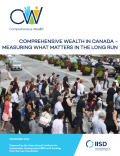In Burkina Faso, more effective macroeconomic management based on policies to promote sustained and sustainable growth remains a priority goal. However, it is now recognized that maintaining rapid growth is not synonymous with structural transformation or a rapid reduction in poverty. To achieve the above-mentioned goals, growth must be deliberately oriented towards sustainable, inclusive development, predicated in particular on a process of agricultural modernization, industrialization tailored to national circumstances and economic diversification which creates jobs, helps to lower poverty levels and gives wider access to basic services. Accordingly, an inclusive green economy, designed in a spirit of structural transformation, is increasingly recommending itself in policy and strategy debates as the most suitable way of bringing about sustainable economic and social transformation.

Comprehensive wealth focuses on the role of people, the environment and the economy in creating and sustaining well-being. Complementing indicators like gross domestic product (GDP) and addressing issues the can’t capture on their own, comprehensive wealth measures are key to successfully guiding Canada through the 21st century and beyond.
This study, Comprehensive Wealth in Canada - Measuring what matters in the long run, reviewed Canada’s comprehensive wealth performance over the 33-year period from 1980 to 2013. This timeframe extends well beyond business and political cycles, ensuring that the results reveal trends free from the ebb and flow of markets and policies. The report found that comprehensive wealth grew slowly in Canada between 1980 and 2013 (0.19 per cent annually in real per capita terms). This was in contrast to relatively robust growth in real per capita consumption of goods and services (1.36 per cent annually). The divergence between these two trends points to potential concerns for long-term well-being.
In terms of the components of comprehensive wealth:
Climate change is relevant to virtually all other SDGs, including Goal 8 on decent work and economic growth. Uncontrolled climate change will not only compromise the ability of countries to achieve this goal, but could reverse gains in economic prosperity, social progress and poverty reduction. Economic sectors particularly vulnerable, such as agriculture, are among the biggest employers. Besides, risks tend to be greater for workers and communities already in situations of vulnerability, including workers in the informal economy, indigenous and tribal peoples, migrant workers, women and youth.
The report aims to examining and documenting the role and significance of various enabling measures that could facilitate a smooth transition to an inclusive green economy in Africa, taking into account the implications of such a transition for the region. The measures examined are: policies and institutions, policy instruments, technology development and transfer, capacity development, and financing the transition.
The report (i) Analyses the implications of the transition to an inclusive green economy for Africa; (ii) Explores measures as they relate to the transition, and analyses trends in the application of the measures; (iii) Discusses challenges and opportunities for an inclusive green economy transition in Africa; and (iv) Puts forward policy recommendations that could enhance the adoption of enabling measures relevant for a smooth transition in Africa.
